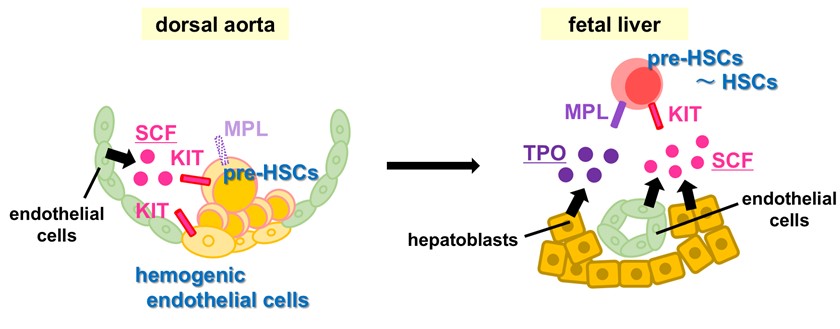Reproduction of Hematopoietic Stem Cell Developmental Process in an in vitro culture system

A Step Toward Future Medical Applications
Researchers at Kumamoto University have achieved a groundbreaking advancement in stem cell biology by reproducing the developmental process of hematopoietic stem cells (HSCs) in vitro. This culture system not only enhances our understanding of how HSCs develop but also leads to the development of a new tool that could be instrumental in stem cell therapy and blood disease treatments in the future.
Hematopoietic stem cells (HSCs), the body's primary source for producing blood cells throughout life, develop through several stages. The research team, led by Professor Minetaro Ogawa and Assistant Professor Saori Morino-Koga from the Institute of Molecular Embryology and Genetics, discovered that specific signaling molecules are necessary at each differentiation stage. The culture system established in their study reproduces the microenvironment where HSC development occurs and has successfully differentiated mouse embryo-derived hemogenic (blood-producing) endothelial cells, which are HSC progenitors, into transplantable HSCs.
This culture system is notably accessible and versatile, as it does not require genetically modified feeder cells or the use of serum that previously limited the scalability and reproducibility of HSC generation. The researchers utilized commercially available endothelial cell lines as feeder cells, adding only two signaling molecules: stem cell factor (SCF) and thrombopoietin (TPO). The result was the successful induction of HSCs from embryo-derived hemogenic endothelial cells, demonstrating the method's effectiveness and potential for broader applications.
The researchers anticipate that this culture system will be a powerful tool for further studies on the molecular mechanisms of HSC development. Furthermore, they hope it will eventually lead to the induction of HSCs from pluripotent stem cells, such as embryonic stem (ES) and induced pluripotent stem (iPS) cells, thus opening new avenues for stem cell-based therapies for blood diseases.

Image Title: Serum-free culture for HSC induction from hemogenic endothelial cells
Image Caption: This study successfully reproduced the developmental process of hematopoietic stem cells (HSCs) in an in vitro culture system using commercially available endothelial cell lines as feeder cells, without the serum. By adding just two signaling molecules, stem cell factor (SCF) and thrombopoietin (TPO), the researchers were able to induce transplantable HSCs.
Image Caption: This study successfully reproduced the developmental process of hematopoietic stem cells (HSCs) in an in vitro culture system using commercially available endothelial cell lines as feeder cells, without the serum. By adding just two signaling molecules, stem cell factor (SCF) and thrombopoietin (TPO), the researchers were able to induce transplantable HSCs.

Image Caption: The pre-HSCs (HSC progenitors) are stimulated by SCF derived from endothelium in the dorsal aorta, but not by TPO. After migrating to the fetal liver, pre-HSCs receive both SCF and TPO signals, allowing them to differentiate into mature HSCs.
Reference
| Authors |
Saori Morino-Koga*, Mariko Tsuruda, Xueyu Zhao, Shogo Oshiro, Tomomasa Yokomizo, Mariko Yamane, Shunsuke Tanigawa, Koichiro Miike, Shingo Usuki, Kei-ichiro Yasunaga, Ryuichi Nishinakamura, Toshio Suda and Minetaro Ogawa* |
| Title of original paper |
Transition of signal requirement in hematopoietic stem cell development from hemogenic endothelial cells |
| Journal | Proceedings of the National Academy of Sciences of the United States of America (PNAS) |
| DOI | 10.1073/pnas.2404193121 |

